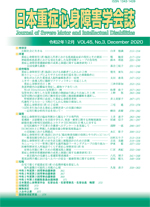Volume 45, Issue 3
Displaying 1-29 of 29 articles from this issue
- |<
- <
- 1
- >
- >|
-
2020Volume 45Issue 3 Pages 215-216
Published: 2020
Released on J-STAGE: March 30, 2023
Download PDF (1589K)
-
2020Volume 45Issue 3 Pages 217-224
Published: 2020
Released on J-STAGE: March 30, 2023
Download PDF (1692K) -
2020Volume 45Issue 3 Pages 225-230
Published: 2020
Released on J-STAGE: March 30, 2023
Download PDF (1920K) -
2020Volume 45Issue 3 Pages 231-240
Published: 2020
Released on J-STAGE: March 30, 2023
Download PDF (1737K)
-
2020Volume 45Issue 3 Pages 241-246
Published: 2020
Released on J-STAGE: March 30, 2023
Download PDF (2011K) -
2020Volume 45Issue 3 Pages 247-252
Published: 2020
Released on J-STAGE: March 30, 2023
Download PDF (2662K) -
2020Volume 45Issue 3 Pages 253-255
Published: 2020
Released on J-STAGE: March 30, 2023
Download PDF (1662K) -
2020Volume 45Issue 3 Pages 257-262
Published: 2020
Released on J-STAGE: March 30, 2023
Download PDF (1973K) -
2020Volume 45Issue 3 Pages 263-266
Published: 2020
Released on J-STAGE: March 30, 2023
Download PDF (1756K) -
2020Volume 45Issue 3 Pages 267-271
Published: 2020
Released on J-STAGE: March 30, 2023
Download PDF (2263K) -
2020Volume 45Issue 3 Pages 273-278
Published: 2020
Released on J-STAGE: March 30, 2023
Download PDF (2780K) -
2020Volume 45Issue 3 Pages 279-282
Published: 2020
Released on J-STAGE: March 30, 2023
Download PDF (1780K)
-
2020Volume 45Issue 3 Pages 283-290
Published: 2020
Released on J-STAGE: March 30, 2023
Download PDF (1774K) -
2020Volume 45Issue 3 Pages 291-297
Published: 2020
Released on J-STAGE: March 30, 2023
Download PDF (1702K) -
2020Volume 45Issue 3 Pages 299-307
Published: 2020
Released on J-STAGE: March 30, 2023
Download PDF (1925K) -
2020Volume 45Issue 3 Pages 309-312
Published: 2020
Released on J-STAGE: March 30, 2023
Download PDF (1669K) -
2020Volume 45Issue 3 Pages 313-318
Published: 2020
Released on J-STAGE: March 30, 2023
Download PDF (1733K) -
2020Volume 45Issue 3 Pages 319-326
Published: 2020
Released on J-STAGE: March 30, 2023
Download PDF (2558K) -
2020Volume 45Issue 3 Pages 327-332
Published: 2020
Released on J-STAGE: March 30, 2023
Download PDF (1972K) -
2020Volume 45Issue 3 Pages 333-340
Published: 2020
Released on J-STAGE: March 30, 2023
Download PDF (1693K) -
2020Volume 45Issue 3 Pages 341-348
Published: 2020
Released on J-STAGE: March 30, 2023
Download PDF (1815K) -
2020Volume 45Issue 3 Pages 349-358
Published: 2020
Released on J-STAGE: March 30, 2023
Download PDF (1693K)
-
2020Volume 45Issue 3 Pages 359-363
Published: 2020
Released on J-STAGE: March 30, 2023
Download PDF (1672K)
-
2020Volume 45Issue 3 Pages 365-366
Published: 2020
Released on J-STAGE: March 30, 2023
Download PDF (1445K) -
2020Volume 45Issue 3 Pages 367-368
Published: 2020
Released on J-STAGE: March 30, 2023
Download PDF (1445K) -
2020Volume 45Issue 3 Pages 369-370
Published: 2020
Released on J-STAGE: March 30, 2023
Download PDF (1444K) -
2020Volume 45Issue 3 Pages 371
Published: 2020
Released on J-STAGE: March 30, 2023
Download PDF (1440K) -
2020Volume 45Issue 3 Pages 372
Published: 2020
Released on J-STAGE: March 30, 2023
Download PDF (1505K) -
2020Volume 45Issue 3 Pages 376
Published: 2020
Released on J-STAGE: March 30, 2023
Download PDF (1492K)
- |<
- <
- 1
- >
- >|
